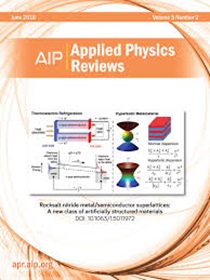Direct x-ray scattering signal measurements in edge-illumination/beam-tracking imaging and their interplay with the variance of the refraction signals
IF 11.9
1区 物理与天体物理
Q1 PHYSICS, APPLIED
引用次数: 0
Abstract
X-ray dark-field or ultra-small angle scatter imaging has become increasingly important since the introduction of phase-based x-ray imaging and is having transformative impact in fields such as in vivo lung imaging and explosives detection. Here, we show that dark-field images acquired with the edge-illumination method (either in its traditional double mask or simplified single mask implementation) provide a direct measurement of the scattering function, which is unaffected by system-specific parameters such as the autocorrelation length. We show that this is a consequence both of the specific measurement setup and of the mathematical approach followed to retrieve the dark-field images. We show agreement with theoretical models for datasets acquired both with synchrotron and laboratory x-ray sources. We also introduce a new contrast mechanism, the variance of refraction, which is extracted from the same dataset and provides a direct link with the size of the scattering centers. We show that this can also be described by the same theoretical models. We study the behavior of both signals vs key parameters such as x-ray energy and scatterer radius. We find this allows quantitative and direct scattering measurements during imaging, with implications in all fields where dark-field imaging is used.边缘照明/光束跟踪成像中x射线直接散射信号的测量及其与折射信号方差的相互作用
x射线暗场或超小角度散射成像自从基于相位的x射线成像引入以来变得越来越重要,并在体内肺成像和爆炸物检测等领域产生了变革性影响。在这里,我们展示了用边缘照明方法获得的暗场图像(无论是传统的双掩模还是简化的单掩模实现)提供了散射函数的直接测量,它不受系统特定参数(如自相关长度)的影响。我们表明,这是具体的测量设置和随后的数学方法来检索暗场图像的结果。我们显示了与同步加速器和实验室x射线源获得的数据集的理论模型的一致。我们还引入了一种新的对比机制,即从同一数据集中提取的折射方差,并提供了与散射中心大小的直接联系。我们证明这也可以用相同的理论模型来描述。我们研究了两种信号在x射线能量和散射体半径等关键参数下的行为。我们发现这允许在成像过程中进行定量和直接的散射测量,这对使用暗场成像的所有领域都有影响。
本文章由计算机程序翻译,如有差异,请以英文原文为准。
求助全文
约1分钟内获得全文
求助全文
来源期刊

Applied physics reviews
PHYSICS, APPLIED-
CiteScore
22.50
自引率
2.00%
发文量
113
审稿时长
2 months
期刊介绍:
Applied Physics Reviews (APR) is a journal featuring articles on critical topics in experimental or theoretical research in applied physics and applications of physics to other scientific and engineering branches. The publication includes two main types of articles:
Original Research: These articles report on high-quality, novel research studies that are of significant interest to the applied physics community.
Reviews: Review articles in APR can either be authoritative and comprehensive assessments of established areas of applied physics or short, timely reviews of recent advances in established fields or emerging areas of applied physics.
 求助内容:
求助内容: 应助结果提醒方式:
应助结果提醒方式:


